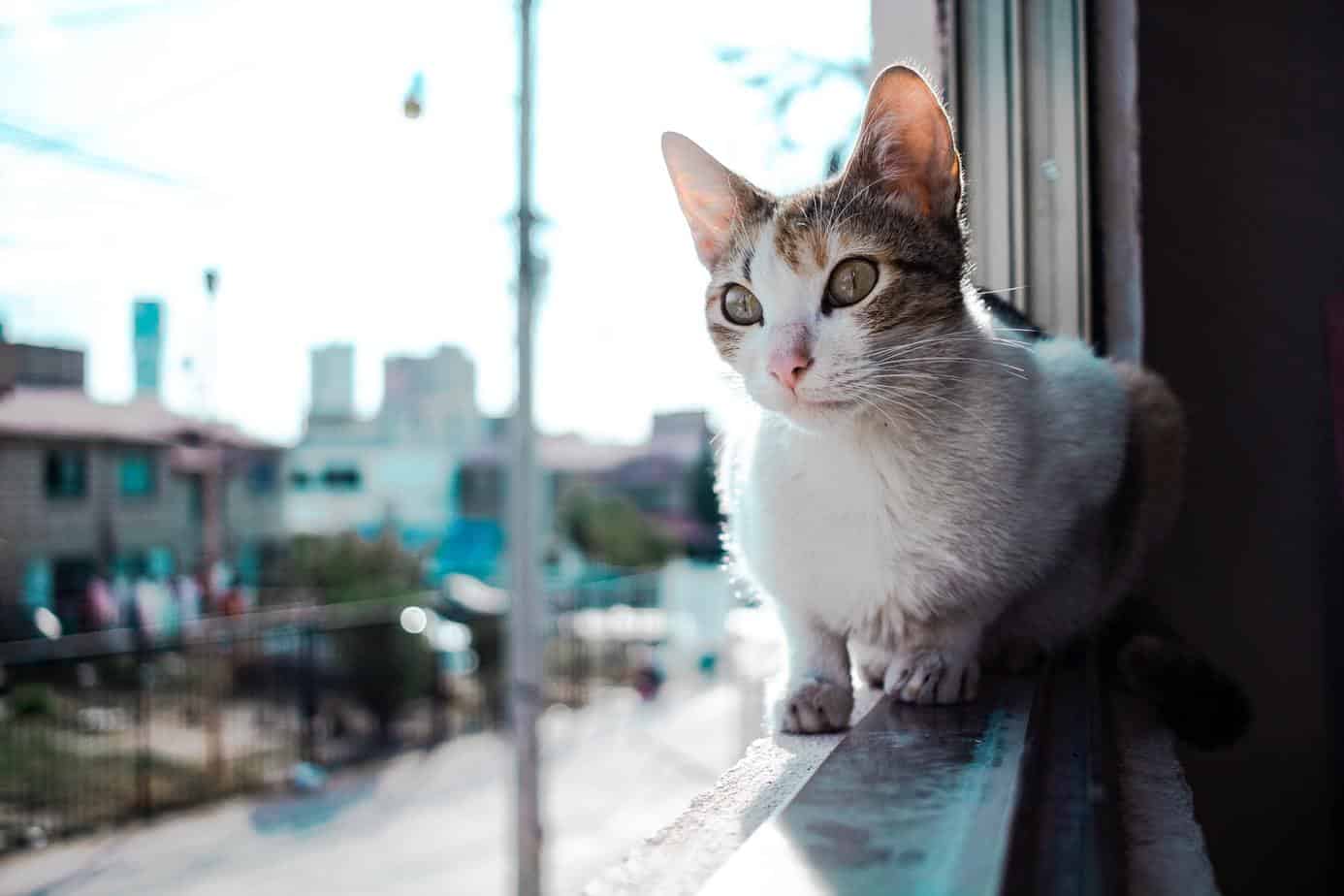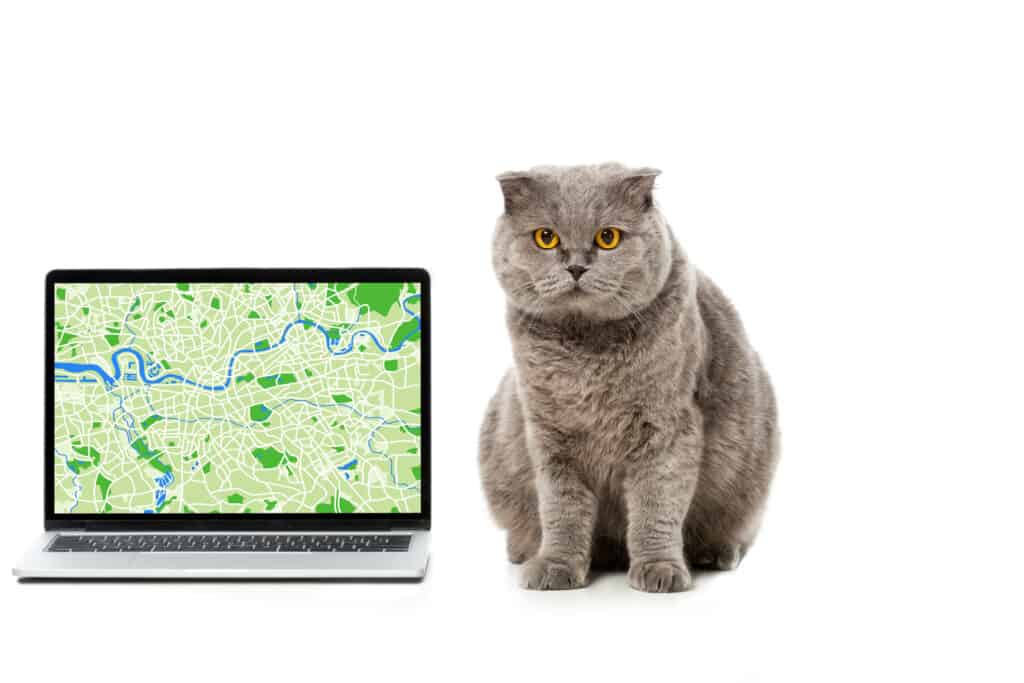If it were up to us, we would probably want to have our cats close to us 24 hours per day. However, cats enjoy their alone time, and some enjoy exploring the outside world. Most of the time, cats can manage themselves well when outside, but sometimes, they get unlucky, and something happens to them that prevents them from coming home safely.
Why does your cat need a tracker?
Many cat owners prefer to let their cats enjoy time outside, but they feel much more at ease when able to monitor their cats’ whereabouts. Studies have shown that two-thirds of lost cats never make it back home. For this reason, cat GPS tracking devices have grown in popularity in recent years.
My experience…
I recently decided to get a GPS tracker for our cat, Max. As it turned out, it’s not as simple as just getting any tracker from Amazon or your local pet store.
To make an informed choice about what kind of tracker would work best in our specific situation, and came with the features that we needed, I did quite some research.
I’m not going to tell you which tracker is the best or which one you should get for your cat. That depends entirely on what you need it for and what your personal use case is.
With this article, my aim is to point out the different trackers that are available, their functionality, and their pros and cons so you can make an informed decision and not waste your time and money.
Different types of cat trackers
There are many different types of trackers on the market. They differentiate in quality, functionality, and design. Choosing the right tracker for your situation may depend on your budget, requirements, and personal preferences.
However, before shopping for a cat tracker, we advise you to familiarize yourself with the different technologies available.
Choosing the right technology for your specific use case is essential. We’ll walk you through the most common technologies available. After that, we’ll go into more detail and specific functionalities that might be important to you.
GPS cat tracker
Whenever speaking about a cat or pet tracker, GPS is the technology that comes to mind most often because most of us are used to this technology.
One could argue that GPS trackers are among the most feature-rich, and because they work seamlessly with our smartphones, it’s easy to see why many people prefer this type of cat tracker. However, there are a few drawbacks to be aware of.
How does it work?
A GPS cat tracker uses the GPS signal available worldwide, which many of us use on almost a daily basis to navigate to wherever we want to go.
Because GPS trackers rely on signals sent to the ground from satellites in space, it is sensitive to structures that might block its signal from reaching the receiver in the tracking device. Similarly, the GPS in your car or phone doesn’t work when you’re driving through a tunnel.
Some GPS receivers are better than others. We have seen some of the cheaper ones having issues when blocked by a tree, while the more expensive models performed better.
GPS in combination with 3g/4g/LTE
All GPS cat trackers come with built-in mobile connectivity. This is needed for two reasons;
- To overcome challenges with GPS connectivity. By triangulation, the device can calculate the position of your kitty in the absence of a GPS signal, albeit less accurate and depends on the availability of a mobile signal.
- To send back the location data to you. Most GPS trackers come with a mobile app which is used to pinpoint your cat’s location on a map. The cat tracker communicates with the app over the internet, and therefore, an mobile internet connection is needed.
For this reason, GPS trackers take a mobile sim card, just like your phone, and need a data plan to connect to the internet.
For some trackers, the manufacturer provides the mobile subscription via them and you sign up for it at the time of purchase. Others will give you the option to use your own sim card and provider.
Pros and cons of a GPS tracker
| Pros | Cons |
|---|---|
| Reasonably accurate | Accuracy depending on GPS reception |
| Easy to use mobile app | Relative short battery life |
| Often comes with extra functionality like geofencing | Can be bulky |
| A mobile plan is required (monthly cost) |
Radio frequency cat tracker
Another option is the radio frequency cat tracker or ‘RF tracker’ for short. This type of cat tracker works by sending and receiving a radio signal that works something like a radar you might find on a ship or airplane.
By interpreting the signal strength and direction, the receiver will indicate in what direction relative to you your cat is located and (roughly) how far you are from it. You can compare this with how a compass works.
Because this is relatively old tech, these trackers are less accurate than their GPS counterparts. On the other hand, they come with some advantages as well.
Considerations when choosing an RF cat tracker
- Range: some RF trackers have a much wider range than others. Generally, RF trackers work within a few hundred feet. If your cat is out of range, finding them is based on trial and error and might be a frustrating exercise.
- Accuracy: RF trackers will not give you the exact location of your cat. Instead, they will guide you in the right direction. Once close, you can find your cat visually.
Pros and cons of an RF cat tracker
| Pros | Cons |
|---|---|
| Tiny unit (increased cat comfort) | Less accurate than a GPS tracker, gives general direction only |
| Relatively cheap | No mobile app |
| Long battery life | |
| No mobile plan is required |
Bluetooth cat tracker
Bluetooth cat trackers are relatively new and use the Bluetooth functionality of our smartphones.
Because this tracker is based on smartphone functionality, it comes with a mobile app for increased functionality.
As most of us know, the range of a Bluetooth signal is limited. The maximum range is about 30-35 feet outside and less when inside.
This type of cat tracker is most suitable for cats who don’t wander too far from home, for indoor cats, or to use when you go trailing with your cat.
Tracking devices based on Bluetooth
Other Bluetooth-based tracking devices on the market may be a good alternative, although not specifically designed to be used as a pet tracker.
An example of this is the ‘Tile’. Tile is a Bluetooth device that can be attached to anything for tracking purposes. When another tile user (someone with the Tile app on their phone) comes within range of your Tile tracker, it updates its location to your mobile app.
Obviously, it is heavily dependent on other Tile users being in the vicinity of your cat, and therefore, it may not be suitable for the more remote locations.
Apple Airtags
Apple Airtags is a tracking system that exists completely within the Apple eco-system. It allows for any object or person to be tracked within the ‘find my’ app from any Apple device. It does not rely on GPS or mobile networks and for Apple devices with a so-called ‘U1’ chip (iPhone 11 and up), objects can be tracked with great accuracy.
I have listed this tracking option under Bluetooth trackers since it also uses Bluetooth. However, Airtags are much more accurate than the standard Bluetooth trackers and it is possible to locate the tracker within inches of accuracy.
Because there is no dependency on GPS or mobile networks coverage is probably more reliable. Airtags work based on your phone’s Bluetooth signal when you’re close but rely on the network of billions of Apple devices globally for tracking when you’re out of range. This also means that there are no monthly subscriptions necessary for it to work.
An Airtag is about the size of a quarter, very robust, and has a battery that lasts about a month and can be easily replaced by yourself. If you have an iPhone, this is definitely worth having a look at.
They retail (via apple.com) for $29 each which makes this a very affordable alternative to the regular pet tracking systems.
Pros and cons of Bluetooth trackers
| Pros | Cons |
|---|---|
| Relatively cheap | Short range (30-35 feet), (exception is the ‘Airtag’) |
| Integrates with mobile app | Less accurate than a GPS tracker, gives general direction only (exception is the ‘Airtag’) |
| No mobile plan required |

What about comfort?
Your cat will likely wear the tracking device permanently, and therefore, choosing a device that your cat can wear comfortably will be very much appreciated by your cat.
What is comfortable for one cat may not be comfortable for another cat. In our experience, we had to try several devices before we found one that our cat accepted.
A couple of things to consider:
- Size: some cat trackers, especially GPS trackers, can be pretty bulky. This is not necessarily an issue, especially not for larger cats. However, if you have a tiny cat, putting a bulky device around its neck is probably not comfortable.
- Weight: this could be a factor as well, especially for smaller cats. Usually, cat trackers weigh somewhere in the neighborhood of 10 to 40 grams (0.3 – 1.4 oz), with GPS trackers on the heavier side of that spectrum.
- Attachment: make sure the attachment of the tracker on your cat’s collar is safe and sturdy. Inferior attachments may cause your cat to get stuck on something or cause discomfort when lying down.
Safety first
You might wonder if strapping a device that is sending radio signals continuously is safe for your cat.
All devices approved for sale in the US market have been tested and approved for safe use on humans and animals. The radio signals emitted by these devices are entirely safe and can not cause any disease or hurt your cat in any way.
Because your cat will wear the device around its neck, one thing to look out for is how it is attached to its collar. Check if there are no sharp edges or other objects that can hurt your cat.
Since all these devices need a battery to operate, ensure that the battery is stowed away safely and securely and has no risk of falling out or getting exposed.
What cat tracker is right for you?
When choosing what cat tracker is best for you and your cat, there are a few things to consider. Let’s tackle them one by one.
Ease of use
When looking at ease of use, we distinguish two categories;
- Ease of operating the device
- Ease of finding your cat
Ease of operation
As a general rule, we can state that the easiest to operate is the RF cat tracker. These cat trackers have a minimum of added functionality, buttons, and gadgets. Their only function is to point you in the right direction when searching for your cat.
GPS and Bluetooth trackers come in second; their added functionality makes them more complicated by definition. However, based on the manufacturer, operating your app might be a breeze or a hassle.
Reading customer reviews before you settle on a specific tracker is always a good idea. These often give you a good insight into user experiences.
Ease of cat-finding
For this one, it depends on what you’re looking for in a cat tracker and your specific use case.
The table below shows what we deem to be the best choice for several use cases.
As a rule of thumb, we would say that if accuracy is needed and you want to track your cat over large distances, a GPS tracker is the way to go.
For indoor cats or cats who don’t wander too far, a GPS tracker may not be the best solution because GPS doesn’t work well inside, and it’s likely not accurate enough to pinpoint your cat in smaller spaces.
| Requirement | Best choice |
|---|---|
| For outdoor cats with a large territory | GPS Tracker |
| Needs to work over large distances | GPS Tracker |
| For indoor cats | RF Tracker or Bluetooth Tracker |
| For outdoor cats who don’t wander too far | Any tracker will work |
| Accuracy is necessary (especially outdoors) | GPS Tracker |
Battery life
All cat trackers need electricity and thus carry a battery. Depending on the tech that they use, some might use up their batteries faster than others.
As a general rule, GPS trackers are the most energy-hungry and need a recharge or battery replacement once every few days.
Bluetooth trackers come in second and can go several weeks on a single charge. Energy consumption for Bluetooth devices is related to the Bluetooth version the use. The higher the version, the lower their energy consumption. For example, a battery on a Bluetooth 1.0 device will run out faster than one on a Bluetooth 4.0 device.
The absolute winner in this category is the RF tracker. These are very power efficient and can go months on a single battery charge.
Functionality
The functionality you need in a cat tracker is often a personal preference or driven by specific requirements. These may be an important factor in choosing the right cat tracker for you.
The table below gives a rough overview of the functionality you can expect from each of the different tracker types and can help you decide which one is right for you.
Keep in mind that technology moves fast, and new functionality may become available over time. For example, there are several trackers on the market that now add fitness tracker like functionality to their devices. This will enable you to monitor your cat’s steps and calorie usage.
| Requirement | Best choice |
|---|---|
| Track your cat on a map | GPS and Bluetooth tracker |
| Mobile app | GPS and Bluetooth tracker |
| Longest battery life | RF tracker |
| Works well indoors | Bluetooth and RF tracker |
| Range | GPS trackers require mobile network coverage. They have the most extensive range.RF/Bluetooth trackers work anywhere but the range is limited. |
| Recurring cost | GPS trackers need a mobile plan and thus carry a monthly subscription cost.Bluetooth and RF trackers don’t need this. |
Final words
We all know that feeling when your kitty is out and about and it’s been a while sinc you last saw her. We tell ourselves that she’s probably going to be fine and that we shouldn’t worry so much.
But what if she got lost? What if she was in an accident? This uncertainty can drive us crazy. What better to have certainty that no matter what, you can always find your cat child and bring them home safely?
If you have an outdoor cat, we would definitely recommend getting a cat tracker. It will give you some peace of mind and increase the safety of your cat while outside.
Want to prevent your cat from running away? Have a look at our article on the most common reasons why cats run away.
Related Questions
Do all GPS trackers need a SIM card?
All GPS trackers that let you monitor its location (e.g., through a mobile app) need a SIM card with mobile data connectivity. This is because the location data is sent back to you via the internet and not via the GPS system. Additionally, the mobile signal can be used for triangulation to calculate the location if the GPS signal is obscured.
Can I use a dog GPS tracker on a cat?
You can use a dog GPS tracker on a cat. The functionality of the tracker will work in the same way. However, because these were built with dogs in mind, they might be less comfortable for a cat to wear. For example, they might be larger or heavier, or the collar might not fit your cat well.
Can you put a GPS tracker inside a cat?
Apart from a microchip used to identify cats, there is currently no technology that makes it possible to embed a GPS tracker inside your cat. GPS trackers need a constant electric current and with a tracker inside your cat’s body, it would be impossible to replace the batteries.




